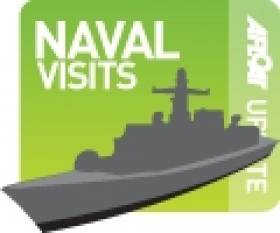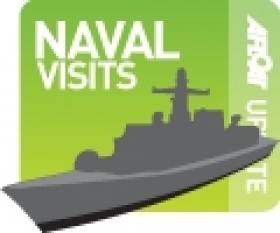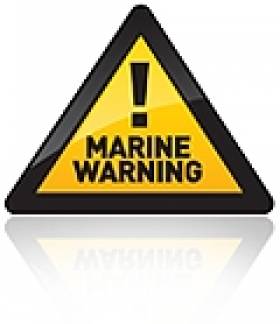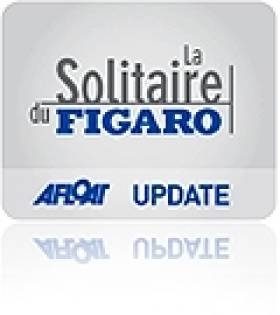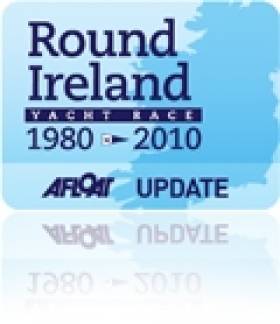Displaying items by tag: Dun Laoghaire Marina
Royal Navy Patrol Boats Return to Dun Laoghaire Marina Adding to Mix of Non-Leisure Craft
#NavalVisits – This weekend Dun Laoghaire Marina is host again to the same pair of Royal Navy 'Archer'-P2000 class training patrol boats that had called earlier this month, writes Jehan Ashmore.
As previously reported the Cardiff based pair HMS HMS Express (P163) and HMS Exploit (P167) with a crew of five each, are used to support the University Royal Naval Units (URNU). It transpires that on the last deployment, the pair did not reach Cork Harbour due to bad weather, however the boats called to Waterford instead.
Each of the 54 tonnes boats can carry university cadets where they train at weekends and during fortnightly deployment trips which can include trips to foreign shores.
The cadets perform a variety of tasks among them fire and flood exercises and navigational skills which also involves use of the flying bridge with its greater visibility.
Such a feature is also paramount particularly for SAR duties of the RNLI lifeboats, where two lifeboats of the service were berthed nearby of the P2000 craft. Also berthed in close proximity was the Irish Revenue Commissioners 23m cutter RCC Faire, a Finnish built 71 tonnes craft which transited Dalkey Sound last Friday.
In addition the largest vessel berthed in the 820-berth marina is the 26m excursion vessel St. Bridget, operated by Dublin Bay Cruises. The 100 passenger vessel is due to start a new service this month running between the harbour's East Pier and Howth Harbour.
Finally, moored alongside the inner berths closer to the shoreline were the research vessels RV Keary belonging to the Geological Survey of Ireland and fleetmate Cosantóir Bradán, which had served a career with Inland Fisheries Ireland.
Dun Laoghaire Marina
Dun Laoghaire Marina is located in the historic harbour of Dun Laoghaire on the south shore of Dublin Bay.
Dun Laoghaire Marina opened for business on St Patricks Day, 17th March, 2001. Dun Laoghaire marina has grown in success and capacity with space for 820 boats. The marina can be accessed 24 hours by boats of up to 4m draft. Berths are available to suit boats from 6m to 30m in length and a maximum displacement weight of 80 tonnes.
Dun Laoghaire Marina is a Five Gold Anchor rated marina with everything you expect from a high standard marina. Friendly and knowledgeable staff that are always on hand to assist you, is part of what makes Dun Laoghaire Marina special.
The Harbour itself was completed in 1859 and was originally intended as a harbour of refuge. Dun Laoghaire is conveniently situated within a short distance of Dublin city centre. There are train and bus connections to the city that stop in front of the marina. There is also a direct coach transfer from Dun Laoghaire to Dublin airport with a journey time of just 45 minutes. There is also a passenger ferry connection to the UK which departs daily from Dun Laoghaire Harbour.
The town of Dun Laoghaire itself is home to a vast array of amenities. This includes two shopping centres, a chandlery, banks, pubs, restaurants and a multi-screen cinema all within easy walking distance of the marina.
Royal Navy Patrol Craft Dock In Dun Laoghaire Marina
#NavalVisits-A pair of Royal Navy 20m inshore fast patrol boats berthed yesterday in Dun Laoghaire Marina, having previously called to Cork Harbour over the Easter weekend, writes Jehan Ashmore.
HMS Express (P163) and HMS Exploit (P167) with a crew of five each, belong to a 14 strong fleet of Archer P2000 class and they form the First Patrol Boat Squadron. Both vessels are based in Penarth Marina, near Cardiff.
Their primary role is to support the University Royal Naval Units (URNU) but they also contribute to a wide range of fleet tasking. The URNU is based at HMS Cambria, a Royal Navy Reserve establishment near the Welsh capital.
Research Vessel Speeds Home following Modification Work
#ResearchVessel – The Geological Survey of Ireland (GSI) research vessel Keary, returned to her homeport of Dun Laoghaire Harbour today, having completed modifications at Arklow Marine Services, writes Jehan Ashmore.
The South African built aluminium catamaran craft had been hoisted onto the quayside at the Co. Wicklow port so to allow the work to begin.
She made her homebound journey with a high-speed transit through Dalkey Sound, and completed her voyage to the 820-berth Dun Laoghaire marina.
As previously reported on Afloat.ie the RV Keary was joined in October by the former Inland Fisheries Ireland cutter, Cosantóir Bradán. She is employed as part of INFOMAR, the national marine mapping programme, conducted by the GSI and Marine Institute.
Courtown Harbour Rowing Club took second place in a time of 3:3:19 and third place honours went to Stella Maris Rowing Club with a time of 3:16.00. The hosts of the Hobblers Challenge, St. Michaels Rowing Club based out of the Coal Harbour, passed under the high walls of the East Pier Lighthouse and battery some two minutes later in fourth place.
The annual event (for race-route click HERE) was only re-introduced onto the race calendar last year after a break of several years. The skiffs were launched at the Coal Harbour slipway where they headed over to line-up for the starter's gun opposite the Hobbler's Memorial located on the publicly accessible Eastern Breakwater which is between the Stena Line HSS fast-ferry berth and the Dun Laoghaire Marina.
In attendance to greet the start of the race in memorial of the Dublin Bay hobblers was the RNLB Anna Livia of the local RNLI lifeboat station. The bronze memorial depicts a tower of lifejackets in commemoration of three young Dun Laoghaire hobblers who after piloting and unloading the schooner Jealous of Me in Ringsend, failed to return home.
This occupation was carried out by men also from Ringsend, Dalkey and other harbours and it was the first crew to reach a ship and throw a hook on the deck who would win the business of pilotage and unloading in Dublin Port.
Crews would think nothing of rowing out to the Kish Bank on the hope of spotting a ship. If they waited offshore and no passing trade appeared along the East Coast the craft doubled as a bed if it became too late to row home. The craft were much larger and heavier compared to the present day skiff and it is in these oarstrokes that the Hobblers Challenge follows the original race of the hobblers during the 18th and 19th centuries.
It was apt that on the same day of this year's Hobblers Challenge, the 107-year-old ketch Bessie Ellen, a former cargo-carrying vessel that represented one of the last such sail-trading ships operating in the Irish Sea, was making a passage to the east of the Kish Bank.
To read more about the un-manned Kish Lighthouse click this HERE, and for the 150 cargo tons capacity ketch built in 1904 click HERE.
- Dublin Port
- Fishing
- Dun Laoghaire Marina
- Dublin Bay News
- Irish Lights
- Dun Laoghaire Harbour
- Kish Bank
- Ferry news
- Stella Maris Rowing Club
- Kish Lighthouse
- East Coast skiffs
- Dun Laoghaire Harbour and news
- Stena Line HSS Dun Laoghaire
- Hobblers Challenge
- Dublin Bay pilots
- Rowing news
- Coal Harbour Dun Laoghaire
- St. Michaels Rowing Club
- Courtown Rowing Club
- St.Patricks Rowing Club
- Ringsend skiff clubs
Dun Laoghaire Replaces Malahide as Relief Lifeboat Base
Dun Laoghaire Harbour has replaced Malahide as the new location for a relief lifeboat base which is to serve the RNLI's Irish Division, writes Jehan Ashmore.
Dun Laoghaire was chosen because of the strategic central location on the Irish Sea. The base benefits the service in providing improved emergency response times and savings on fuel costs. The Severn-class lifeboat RNLB Osier (17-34) has been one of the designated relief lifeboats to be based in the marina.
An added attraction in choosing Dun Laoghaire is the ability to haul lifeboats out of the water for maintenance and repairs. The boat-lift hoist and transport trailer facility is operated by MGM Boats Ltd and is conveniently sited within the boundary of the marina. In addition the RNLI also operate the lifeboat station beside the Carlisle Pier. The station is served by the Trent-class RNLB Anna Livia and a new inshore-lifeboat (ILB) the Realt Na Mara which entered service during the summer.
Related Safety posts
RNLI Lifeboats in Ireland
Safety News
Rescue News from RNLI Lifeboats in Ireland
Coast Guard News from Ireland
Water Safety News from Ireland
Marine Casualty Investigation Board News
Marine Warnings
Dun Laoghaire Yacht Theft - Watch Out, Thieves About!
The boating community has been alerted to a recent theft from a boat at Dun Laoghaire marina. Boaters have been asked to keep an eye out for 'suspicious characters purveying marine equipment.
It is understood a 54ft yacht was broken into on Dun Laoghaire marina at some stage on Sunday 3rd or Monday 4th. The person(s) in question took a number of items, including 6in. and 12in. Navman Plotters, 2 Icom Handheld VHF's, power and hand tools, a 10 inch lcd Monitor, Helly Hansen oilskins, safety equipment, a marine pc and possibly other items that have just not been noticed missing yet.
Obviously the thief(s) in question knew what they were doing, and it has been described as a "slick and thorough job".
If anyone has any information about this incident, please contact Dun Laoghaire Garda Station: tel; 01 666 5000
Dun Laoghaire to Host Top French Race in 2011
In a major announcement for Dun Laoghaire sailing a top French fixture involving 50 single handed yachts will visit the east coast port next Summer. Dun Laoghaire will be the only stop over outside France for next year's prestigious La Solitaire du Figaro race.
The race is regarded as one of the world's solo sailing great events and one of the toughest on the international sailing calendar.
Although having strong connections with Ireland this is the first time the 42 year old fixture will visit Ireland's largest sailing centre.
The fleet will moor in Dun Laoghaire harbour at the finish of the second leg and hosted by the National Yacht Club. They are expected to stay for a week.
This year the race visited Kinsale and in the past has also visited the Irish ports of Crosshaven, Howth and Dingle.
One month since the finish of the Solitaire du Figaro 2010, event organisers are already looking ahead, to 2011. The 42nd edition announces a new route: four legs, four French ports and one foreign stopover. The full details will be unveiled at the Paris Boat Show, on Friday December 3rd.
La Solitaire is going back to its roots. Perros-Guirec and Brittany from where the race will start on Sunday, 31st July 2011, are the most faithful of all host ports in the history of the race as Perros-Guirec has the record number of participations, this being the 16th time that the town will welcome the race. The last time was in 2005 and there is no doubt that Perros-Guirec will do its absolute best for this comeback.
The second French stopover in 2011 will be Caen, where the race will go back for the third time. The harbour and the village are ideally situated in the city centre and will surely gather thousands of visitors during the week long stay, with a full schedule of social events organised by the local municipality.
The third French rendez-vous is les Sables d'Olonne, which requires little introduction. In 2007, the port in the Vendée region celebrated the victory of Michel Desjoyeaux and since then the local authorities and the town live in very close ties to yachting, always ready to welcome sailors of all sorts, and namely from the Vendée Globe race... undoubtedly the people from Les Sables will show a very warm welcome to the skippers competing on the 42nd edition of La Solitaire next summer, as they have already done on six occasions on previous occasions as a host port for a race start or finish.
Dieppe will host the finish and close of La Solitaire du Figaro 2011 race. The Haute-Normandie region town expects to see the finish on a around August 24th. The town first hosted the race in 2009, regarded as a great success and one that the organisers wish to repeat by returning of for the finish. Locals in Dieppe will welcome the fleet over the final miles and will put on a whole host of celebrations through to Sunday 28th of August for the traditional final parade sail.
Just one stop over outside of France is planned and this is to be held in Ireland. La Solitaire will go to Dún Laoghaire for the first time, just ten minutes from the bustling town centre of Dublin at the finish of the second leg. The second stage promises to be a nice discovery for the Figaro sailors who will appreciate the charming Bay of Dublin and National Yacht Club's members warm welcome.
Perros-Guirec, Caen, Dún Laoghaire, Les Sables d'Olonne and Dieppe: five cities for a 42nd edition marked by many novelties. Sailing across the Channel, the Atlantic ocean, the Irish sea and the Celtic sea, the Solitaire du Figaro 2011 guarantees to be one of the season's greatest sports events.
Preparing for La Solitaire du Figaro here
Latest news for La Solitaire du Figaro here'Rosslare' Blessed in Dun Laoghaire and Bound for Wicklow
The “Spirit of Rosslare Europort”, was the centrepiece of a traditional Irish ceremony in Dun Laoghaire Harbour this afternoon. In an interdenominational event, the yacht took part in the “Blessing of the Boats” ceremony prior to setting out for the Round Ireland Yacht race. The ceremony was conducted by Fr John McDonagh from Dalkey and the Rev. Gary Dowd from Glenageary.
The Blessing of the Boat’s ceremony is a widespread tradition all around the coast of Ireland and on inland waters. Annual ceremonies take place in Bulloch Harbour in Dalkey, and in other centres around Dublin, including Poolbeg and Balbriggan, and are often a part of local festivals. Boats of all sorts and sizes participate, ranging from sea going trawlers to sailing yachts, Galway Hookers, lifeboats and small craft.
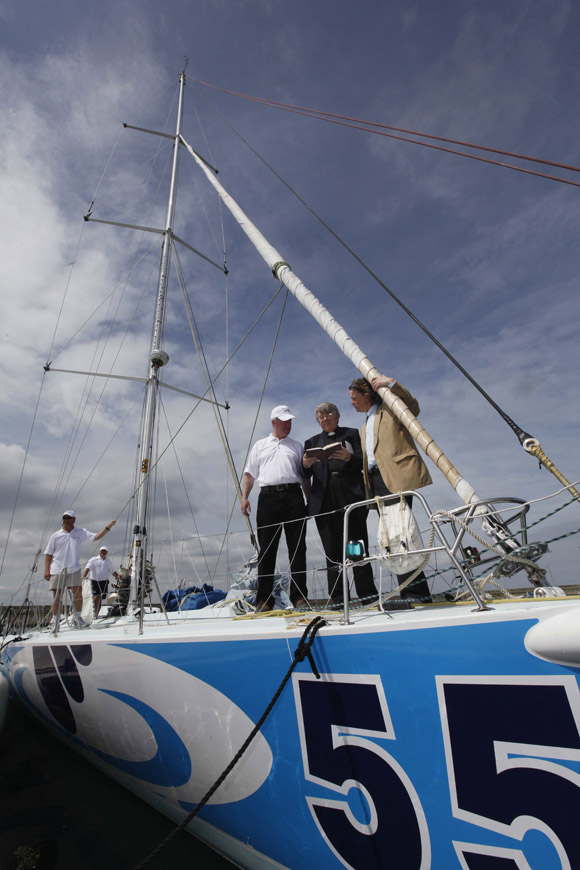
Pictured at the blessing of The Spirit of Rosslare Europort yacht were Alan McGettigan, Fr John McDonagh and Rev.Gary Dowd, at Dun Laoghaire Marina, with crewmen Peter O'Mally and Paul O'Riain in the background. The 60 foot yacht is competing in this weekend's Round Ireland Race.
Speaking at the blessing, Fr McDonagh said “For centuries the Blessing of the Boats ceremony has been an expression of faith by sea going communities in Ireland and represents an age old tradition”.
The Rev Dowd said: “It is entirely appropriate that in our modern age this ancient tradition should be observed with the blessing of a high technology yacht that has been a leading competitor in round the world races and is now going to circumnavigate Ireland”.
The group sailing the yacht is led by Dalkey man Alan McGettigan whose initiative it was to bring the “Spirit of Rosslare Harbour” to Ireland and to conduct the ancient Irish traditional blessing. An experienced sailor, Mr McGettigan has sailed in areas as far afield as the Baltic Sea, the Caribbean, the South China Sea and the Mediterranean. He is a member of the Royal Irish Yacht Club.
The 60 foot long Spirit of Rosslare Europort has sailed around the world four times, competed in numerous transatlantic races and is expected to be the fastest boat in next week’s 704 mile race around the island of Ireland. The yacht has been sponsored by Rosslare Europort and will be skippered by Steve White, the renowned solo round world sailor who’s company White Ocean Racing owns the vessel.
Sailing enthusiasts will be able to track the Spirit of Rosslare’s progress in the Round Ireland Race on Twitter and Facebook. The Facebook page features photos and video footage thanks to onboard camera’s which will give people an insightful view of how sailors overcome the various challenges during the course of the race.


























